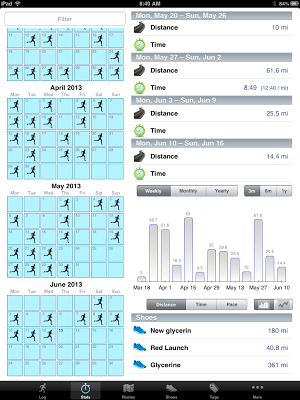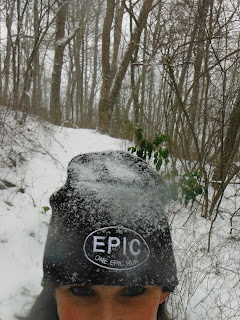It was a dark and stormy night....
I always wanted to start a
race report with that line. But, in
truth, it was anything but dark the night before Vermont 100. Shortly after I climbed into my tent at
Silver Hill Meadows, a torrential storm rolled in with winds that threatened to
rip my tent stakes out of the ground, blinding lightning flashes and booming
thunder. I felt sure that there was
about to be an unfortunate catastrophe, but since I had no option other than to
stay in the tent, I put earplugs in, covered my eyes with my hoodie and tried
to sleep.
When I woke up at 3:15 to get
ready for the 4:00 a.m. start, I couldn't find my flashlight. No problem, I would just use the headlamp
that I brought for the start. I fumbled
in my pack for it, flipped the switch on and nothing happened. Great.
How am I going to start the race without a light?
I was in this
predicament because I had been traveling for two weeks prior to the race and
had kind of thrown things together before I had left home. Apparently, one thing I overlooked was
replacing the batteries in the headlamp.
This was not a great way to start a race that I already had concerns
about. After Leatherwood in April, I
injured my hamstrings and really didn't start back normal training until the end
of May. I only got in five weeks of steady running and no speed work
whatsoever. I was concerned that I
didn't have enough miles in to finish, and if I did, would I be fast enough to
finish before the 30 hour cutoff?
So, for several precious minutes, I fumbled
around in the dark for the flashlight and finally found it down inside my
sleeping bag. At least I would have
light for a little while until those batteries died. I rushed around, ate a granola bar, stood forever in the
porta-potty line and made it to the start just in time for the fireworks.
 |
| photo by Jacqueline Choi |
Yes,
fireworks. A solid five minutes of
fireworks rocked the peaceful Vermont valley at 4 a.m. I couldn't help but wonder what the
neighbors would have to say, but it was a great way to start a race.
 |
| photo from Vermont 100 FB page |
After the
show, we were off into the night. I really can't give you a turn by turn
course description, because so much of it blended together in my mind. It was
80 miles of road, mostly packed crushed gravel. The rest was double track and
single track, some of it very muddy and rocky. So instead of trying to take you
through the course, I'll talk about things that stood out.
 |
| photo by Jacqueline Choi |
An hour after our
start, we heard booms off in the distance.
The race is held simultaneously with a 100 mile horse race, which starts
an hour later, and apparently the
horses were treated to a fireworks show as well. I wondered how much they liked all that noise. Anyway, about an hour later, the first
horses started coming by and this became a pretty cool distraction. I was
surprised at how seamless the interaction between runners and horses was.
 |
| photo by Jacqueline Choi |
Early
on, the course takes you through the small, quaint town of Woodstock. Although
it is a fairly long paved road section, you are rewarded with people lining the
streets cheering, something you don't usually get in an ultra.
 |
| photo by Jacqueline Choi |
The area was
beautiful. You ran through the rolling
countryside dotted with well-kept old farms, some over 200 years old. When you got bored, you had plenty of cows,
horses and donkeys to talk to. At one
point, we ran through an old covered bridge.
The natural scenery was beautiful as well, and you were rewarded with an
incredible view of it from Sound of Music Hill.
 |
| photo by Jacqueline Choi |
At night there was a full moon, illuminating the fields,
reflecting off creeks, and silhouetting the barns and homes. The birch trees looked like they were
brightly lit up in the moonlight. As
the night wore on, a mist rose in the valleys.
I watched the moon setting orange, followed by a purple sunrise. I remarked to another runner that although I
would love to be one of those people who were finished before dark, they really
didn't know what they were missing.
 |
| photo by Jacqueline Choi |
The local people were so friendly. Those working in their yards cheered as you
went by or expressed their disbelief at what you were doing. Some people had set up impromptu aid
stations outside their farms, offering water or a hose down as you went
by. Even at night, there were people
sitting by the course, watching us go by.
The weather
 |
| photo by Jacqueline Choi |
I remarked to
several people about how lucky we were with the weather, but I think that I may
have been in the minority in that belief.
Vermont is known to be hot and humid, and don't get me wrong, it was hot
and humid, but it was not as bad as it could have been. It was cloudy off and on and there was a
breeze all day long. It really felt a
lot like home and I only got a little overheated once, on a Not only did
the humidity itself take a toll on people, but it also led to hypothermia
because everyone's clothes stayed wet into the night. A lot of people had foot
issues from their feet staying wet, as well.
I did have foot problems, but I changed into a dry shirt late in the
afternoon and felt comfortable all night long.
paved road section.
However, apparently there was a bigger drop rate than normal, according to one
of the medical personnel.
So, my race....
Well, it
was 100 miles. Which means that
sometimes I felt really good, which was followed by periods of feeling really
bad.
 |
| mile 48 |
I
decided to try KT tape on my knee which always aches and hurts in long runs
(ACL surgery).
It never hurt a bit and
I didn't even remember I had the tape on, until someone mentioned it.
Early on, however one area on my right quad
started hurting, simultaneously with both hamstrings.
I probably should have done a lot more road running.
Heck, I should have done a lot more
running.
Anyway, it was almost
impossible to bend over to tie my shoes and I kept thinking about how bad my
quad was hurting.
As I was approaching
mile 40, though, I came up on Amy Palmiero Winters, who had taken off her
prosthetic leg and was shaking rocks out of it.
I quit thinking about my aches and pains at that point.
Talking
with Amy and listening to other people's stories helped pass the time. I ran with people who were running their
first 100, people who were trying to do better than last year, people who were
also recovering from injuries, people who were feeling fantastic and people
battling their own demons. I passed
someone who I'm pretty sure had been self-medicating with a little weed.
Seeing
Tony for the first time at mile 40 was a big mental pick-me-up and changing
shoes into a newer pair of Glycerins helped my legs felt better for a
time. The last 25 miles of the race
became pretty rough, though. My feet hurt, my quads were shot and my stomach
turned south on me and I had a hard time eating anything. The last hour of the
race I had really painful hunger pangs, but could eat nothing.
Despite not
having a good day physically, it was one of my better days mentally. I was able to set my negative thoughts, something
I usually struggle with. I told myself
I was getting to enjoy a 100 mile self-guided tour of Vermont and I made it a
goal to see as much of the course in daylight as I could. Then I enjoyed the nighttime.
Whenever my mind started obsessively calculating
how much longer it would take to get to the next aid station, how fast I was
moving, or trying to figure out if I would finish in time, I asked myself,
"What does it matter? I'm doing
the best I can and I'll get there when I get there. In the meantime, enjoy the here and now." Kind words from friends came to my mind and
I focused on those. Tony's common sense
tough love from Massanutten years ago came back when things got really
bad. "What are you going to
do? Sit down in the trail and
die?" No, I guess I'll just keep
going. I spent a lot of time being
thankful that I was able to run 100 again.
And with a no iPod rule, fragments of the strangest songs popped in my
head. Barry Manilow, really?
Race
Organization
I was impressed by how well things were organized. Three
different horse races and a 100k were held simultaneously with the 100 mile
race and not all of them followed the same course. Plastic plates in different colors with arrows were used to mark
the course and they were much easier to follow than streamers. The aid station workers were super helpful,
and Corona and a burger at Margaritaville were a pleasant surprise. An army of medical workers were available
and they checked my blood pressure and pulse at the finish for me. Everything seemed to be done right and I saw
no glitches whatsoever.
I had only two wishes, both of which I could have
addressed myself. The drop bags at the
aid stations were not well organized and I spent a lot of time searching for
mine. It was a huge race with both 100
milers and 100k runners and therefore there was a big pile of bags. The volunteers had put them in order at some
point but by the time I came through, they were pretty messed up. I need to get more noticeable drop bags than
giant ziplocks. Secondly, I really
needed some good solid food late in the race.
The last real food was the burger, sometime before dark. Yes, there was ramen and little sandwiches,
but my stomach needed something pretty substantial. I had only packed light things in my drop bags and in the future,
I need to plan better. I guess I've
been spoiled with egg sandwiches, egg burritos, pizza, bacon, and more at other
races.
In the end, I finished in 27:41, 159th out of the 325
starters. It wasn't pretty towards the
end and while I was a little frustrated at my lack of training, I was also
impressed with my body's ability to keep moving forward despite that lack of
training. When I signed up months ago,
I thought this would be a good opportunity to run under 24, but as the race got
closer, I knew I would be happy with just being able to finish. I was really happy with the KT tape and this
was the first race I ran without any knee discomfort or pain. At Pinhoti, I limped the last 20 miles or
so. I was also really happy at being
able to find a way to keep the negative thoughts at bay.
Vermont was a well-organized, beautiful race
that I would recommend to anyone. It is
not really my type of course with so much road, but I am very glad I came to
run it.
A special thanks to Jacqueline Choi, another Vermont finisher, who took most of these great pics!





















































